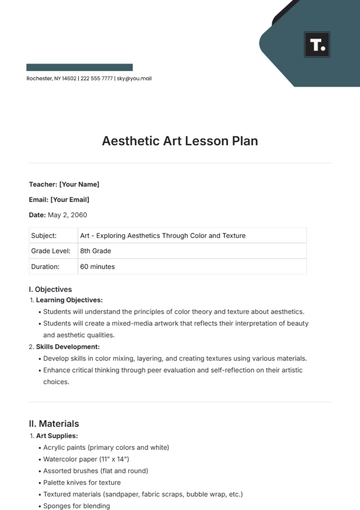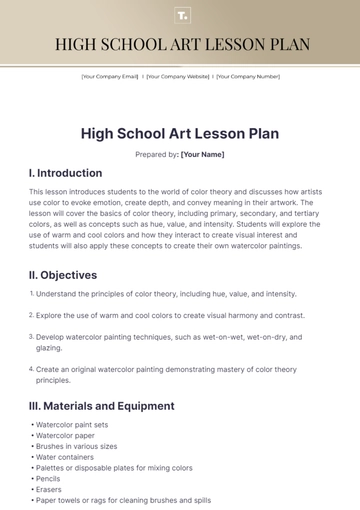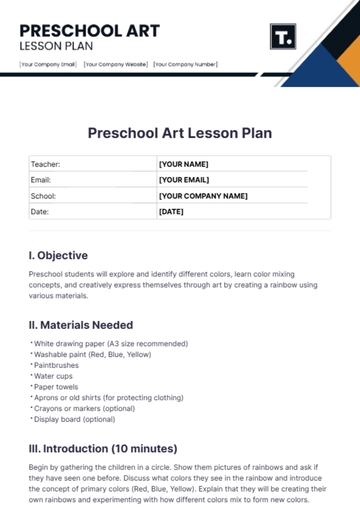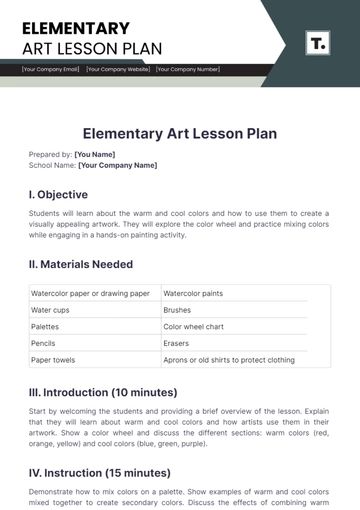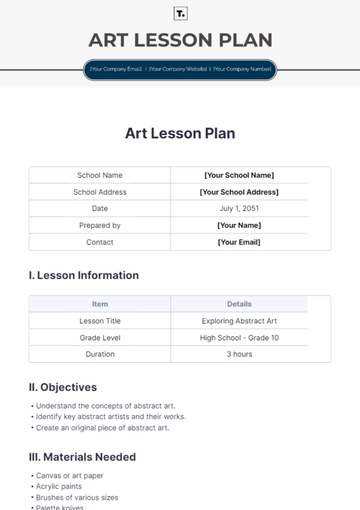Free High School Art Lesson Plan
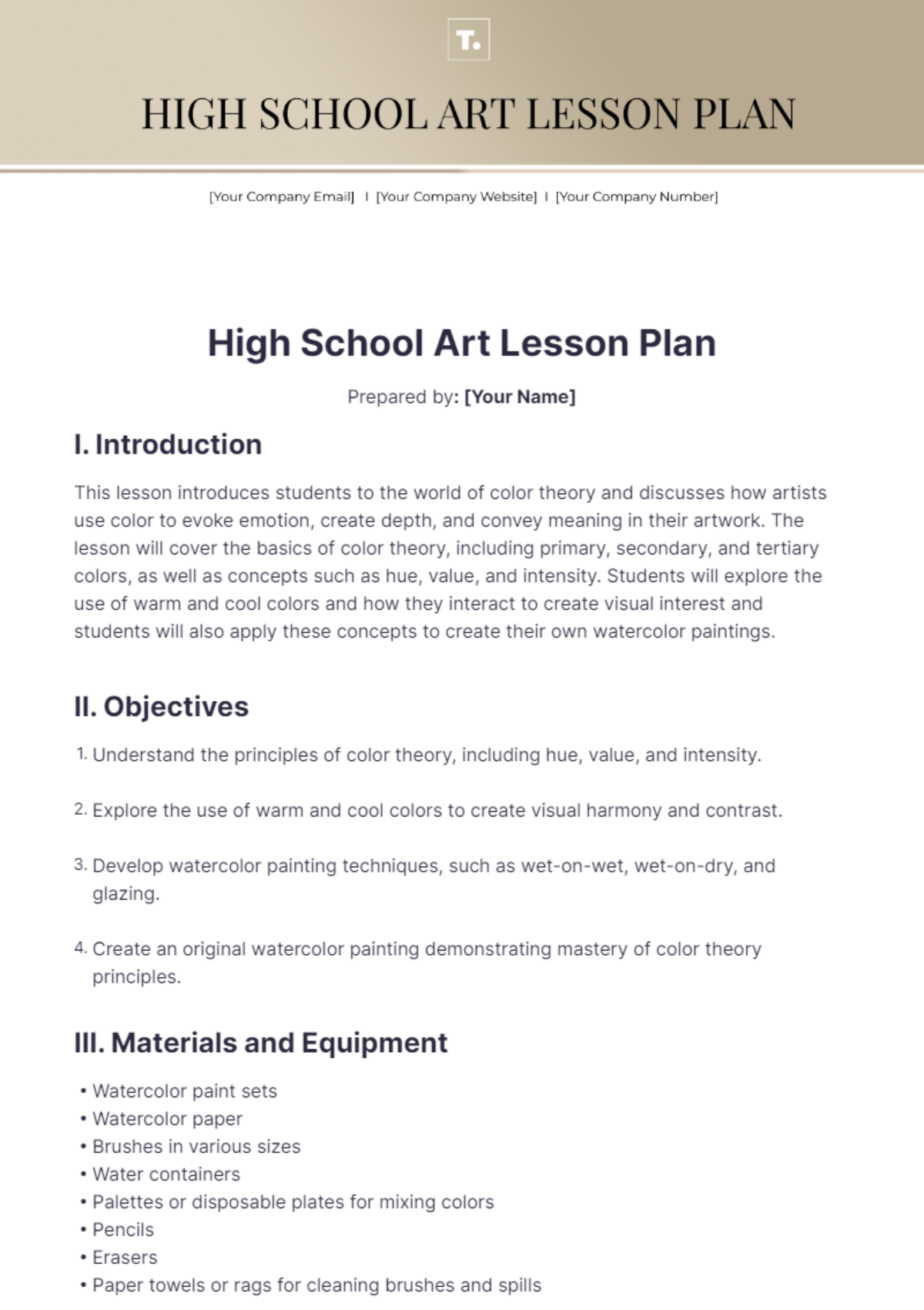
Prepared by: [Your Name]
I. Introduction
This lesson introduces students to the world of color theory and discusses how artists use color to evoke emotion, create depth, and convey meaning in their artwork. The lesson will cover the basics of color theory, including primary, secondary, and tertiary colors, as well as concepts such as hue, value, and intensity. Students will explore the use of warm and cool colors and how they interact to create visual interest and students will also apply these concepts to create their own watercolor paintings.
II. Objectives
Understand the principles of color theory, including hue, value, and intensity.
Explore the use of warm and cool colors to create visual harmony and contrast.
Develop watercolor painting techniques, such as wet-on-wet, wet-on-dry, and glazing.
Create an original watercolor painting demonstrating mastery of color theory principles.
III. Materials and Equipment
Watercolor paint sets
Watercolor paper
Brushes in various sizes
Water containers
Palettes or disposable plates for mixing colors
Pencils
Erasers
Paper towels or rags for cleaning brushes and spills
IV. Demonstration and Instruction
Topic | Description |
|---|---|
Color Theory Basics |
|
Warm and Cool Colors |
|
Watercolor Techniques |
|
V. Guided Practice
Activity | Instructions |
|---|---|
Color Mixing Exercise |
|
Warm vs. Cool Study |
|
VI. Independent Practice
For their independent practice, students will be assigned to create an original watercolor painting that explores the use of warm and cool colors to convey a specific mood or theme. They will apply the color theory principles and techniques learned during the demonstration and guided practice to their own artwork.
Students will have the freedom to choose their subject matter, whether it's a landscape, still life, or abstract composition. Throughout the independent practice session, the teacher will provide one-on-one guidance and support to help students refine their ideas, troubleshoot technical challenges, and make creative decisions.
VII. Critique and Reflection
Following the completion of their watercolor paintings, students will participate in a group critique where they will share their finished artworks and discuss how effectively they used warm and cool colors to achieve their intended mood or theme. They will also reflect on their creative process, the challenges they encountered, and areas for improvement in their use of color and technique.
In addition to the group critique, students will be encouraged to write a brief reflection on their painting process, discussing their artistic choices, what they learned from the experience, and how they might apply these insights to future artworks.
VIII. Assessment
Assessment of student learning will be conducted using a rubric that evaluates their understanding of color theory principles, proficiency in watercolor techniques, creativity, and craftsmanship demonstrated in their original paintings.
In addition to the rubric assessment, the teacher will also consider the depth of students' reflections and their active participation in the critique process. Feedback provided during the critique session will be used to inform future instruction and guide individualized support for students as they continue to develop their artistic skills and understanding of color theory.
IX. Extensions or Enrichment
To extend their learning, students will be offered additional resources or readings on famous artists known for their use of color, such as Vincent van Gogh or Henri Matisse. They will also have the opportunity to experiment with other watercolor techniques, such as salt effects or masking fluid, to further expand their artistic skills and creative repertoire.
For students who demonstrate a strong interest and aptitude in watercolor painting, the teacher may offer advanced tutorials or independent study projects tailored to their individual goals and interests, providing opportunities for deeper exploration and refinement of their artistic practice.
- 100% Customizable, free editor
- Access 1 Million+ Templates, photo’s & graphics
- Download or share as a template
- Click and replace photos, graphics, text, backgrounds
- Resize, crop, AI write & more
- Access advanced editor
Inspire creativity with the High School Art Lesson Plan Template offered by Template.net. This downloadable and printable template is perfect for art educators seeking a comprehensive and flexible planning tool. Easily customizable and editable in our AI Editor Tool, it empowers you to design lessons that cater to diverse artistic skills and interests, encouraging students to explore their creativity and express themselves through various art forms.
